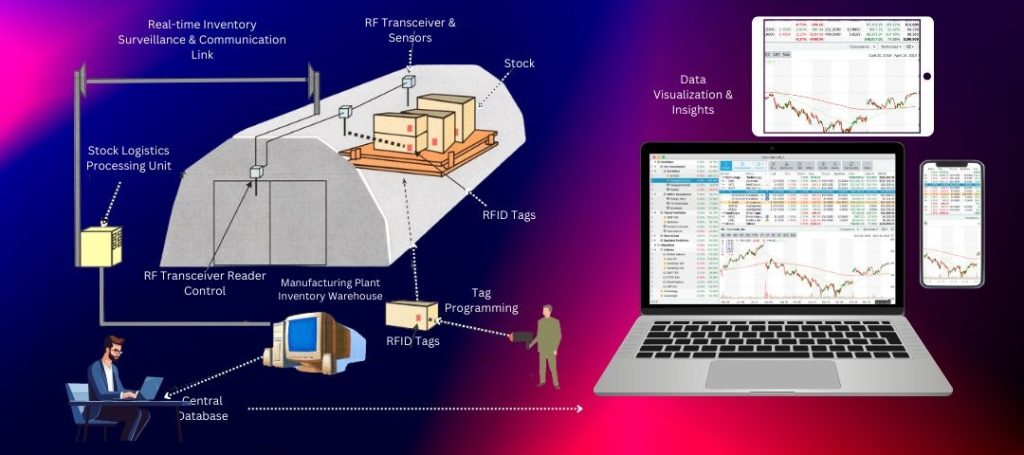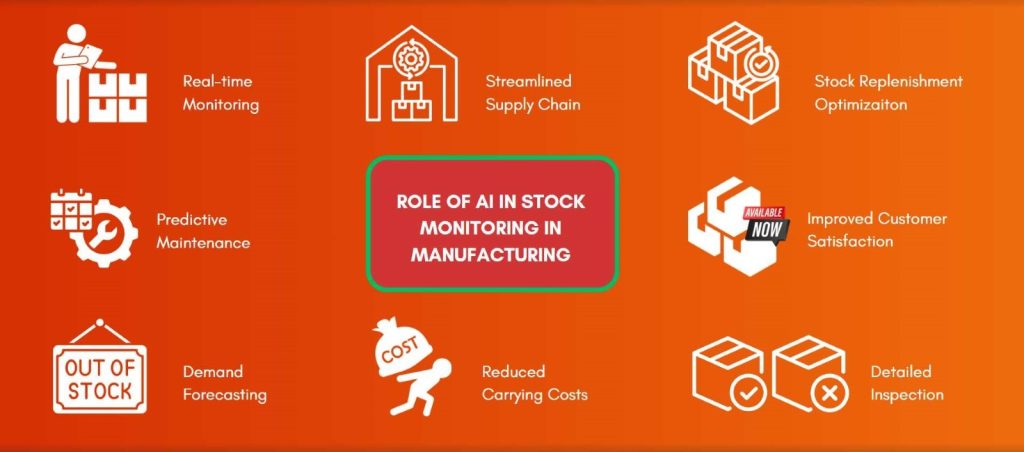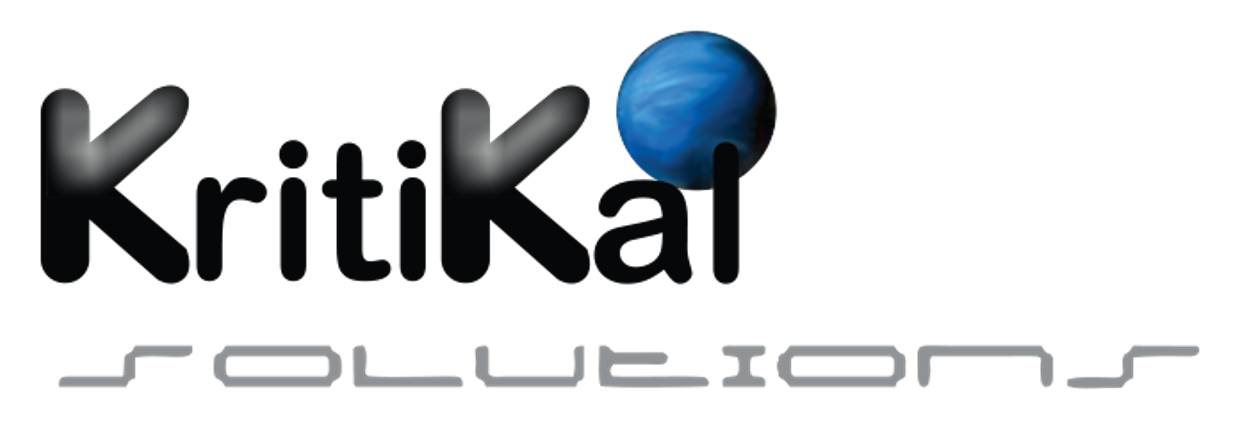The Imperative of Stock Monitoring Systems
Stock monitoring is the process of inventory control, tracking and managing the transit and location of inventory. It is important for businesses to understand customer behavior, know about best-selling products, their positioning on shelves, conduct efficient warehouse and supply chain management, frequency of turning over inventory and the deeper know-how of cross-selling. Effective inventory stock monitoring systems allow them to keep watch on the levels of product stock as per fluctuating consumer demands and fulfill the same in a timely manner, which in turn helps in deepening customer loyalty and retention. Although manually tracking all these factors can be cumbersome, time-consuming and resource intensive. With the intervention of Artificial Intelligence-driven inventory control software stock management is eased with accurate predictions which are primarily based on existing sales records and market tendencies.
The AI-based manufacturing inventory tracking system market is expectedly booming at a CAGR of 22.8% during the time period from 2022 to 2027 and is expected to attain a value of US $10.37 billion.

Booming AI-based inventory stock management system market from 2016 to 2028
Limitations of Traditional Stock Monitoring Systems
- Manual Inventory Tracking: It involves recording item or product counts and movement of stock manually. It may be feasible for businesses running smaller operations to replenish orders using this system, but as the inventory, subsidiaries and branches increase, data entry becomes prone to errors and causes delays in updating the records. They seldom provide real-time visibility and lead to misinformation related to inventory. Excel spreadsheets are easy to use, flexible and familiar to many, but they offer limited capabilities such as lack of data integration for better accessibility when restricted to local systems.
- Internal Audits: In the manufacturing industry, a complete physical inventory audit involves manual counting of stocks periodically. These annual or quarterly audits can help businesses by providing a look-through of inventory levels but only at that specific time. They help in identifying stock anomalies, data entry discrepancies and reconciling, but at the cost of disruptions in operations for longer durations. They do not assist in exhibiting a pro-active approach towards changes in market demand or supply due to limitations in gaining real-time insights into manufacturing factory, warehouse and customer experience in retail.
- Backup Inventory: Safety stocks are used to mitigate uncertain market demands, where a minimal buffer quantity of stocks is preserved in addition to utilizing manual manufacturing inventory tracking system. These static safety stocks can temporarily dismiss supply chain disruptions but need not necessarily reflect and cater to unexpected customer demand spikes in real-time. As a result, businesses tend to carry excess safety stock with certain expiry, held-up capital and worse situations of stockouts due to inadequacy of buffer stocks, instead of earning maximum profits during peak demand.
- Optimum Lot Sizes: The Economic Buying Quantity or Economic Order Quantity (EOQ) model is yet another means of calculating optimal order quantities since 1913. It can be used to reduce inventory, holding and ordering costs by using a mathematical framework that determines quantities by considering fixed costs and consumer demand patterns. A major setback in this model is variation in costs, inflation, market fluctuation, contingent situations like the pandemic with restriction in logistics etc., rendering it as ineffective in the dynamic manufacturing industry as compared to modern inventory stock management systems.

Working of stock monitoring system
Implementation of Inventory Stock Management System
- Data Collection: Stock monitoring powered by AI requires collection of data on inventory levels, manufacturing operations, production process, working condition of machineries and more from thermal, weight (piezoelectric) and motion sensors, radio-frequency identification (RFID) tags, computer vision-based cameras, IoT devices etc. Various types of data collected are transmitted to the central system or cloud database via Wi-Fi, Bluetooth or cellular network for AI video analytics.
- Data Processing: AI models and algorithms in stock monitoring systems process and analyze the collected data after cleaning, removing any inconsistencies, and transforming into suitable format, for example, models used for IBM MRO inventory optimization, AWS systems manager inventory etc.
- Prediction Models: Some commonly known machine learning models used in AI-based manufacturing inventory tracking system include Regression models that predict continuous values like inventory values and machinery life to understand optimal parameters, as well as Classification models in manufacturing inventory tracking systems that categorize data into factors for potential failures or optimum operational performance. These may also include Anomaly Detection models that identify irregular data patterns leading to issues, and Time Series analysis used for future inventory level prediction based on historical sales data, seasonal market trends, etc. Some AI models like neural networks are used to complex AI pattern recognition and anomaly detection that prevent stockouts, excessive safety stock levels or machinery failure. Decision trees that empower regression and classification tasks provide accurate and interpretable results and are thus suitable for decision-making. Support Vector Machines are also used for classification of patterns and data anomalies, whereas K-Means Clustering groups similar data points to highlight trends and patterns in larger datasets.
- Key Insights: Post data analysis, insights are generated by the system, upon which its recommendations to maintain optimal inventory levels are defined. It is also useful for scheduling machinery maintenance and improving task-based efficiency by automating actions as per the complexity of the decision.
- Reporting and Analytics: Manufacturers can track key metrics in real-time and make timely decisions. Visualization dashboards represent important information in an easily understandable format and alerts can be received across various branches, manufacturing plants, platforms, devices and management levels.
Impact of AI in Stock Monitoring Systems
Real-Time Tracking
AI-powered logistics and inventory control mechanism utilizes sensors, RFID tags, computer vision-based cameras and IoT devices to provide real-time data on stock levels while continuously communicating with the central database system regarding Stock Keeping Units (SKUs) rationalization, identification of slow-moving or obsolete inventory. It brings about substantial improvement in inventory management, an up-to-date view, real-time location and quantity tracking of raw materials, finished or manufactured products as they pass through different stages of production. The heuristic nature of manufacturing inventory tracking systems ensures secured and balanced stock levels with a reduction in risk of stockouts and overstocking.
Demand Forecasting
Machine learning algorithms can analyze historical sales records, market demands, trends and predict inventory requirements in the future. Manufacturers can stay one step ahead in inventory level optimization and dynamic workforce allocation through accurate forecasts based on production schedules and seasonal market trends of the past. As discussed earlier, different types of neural networks, regression models, ensemble algorithms, and time series analysis integrated with first-in-first-out (FIFO) or first-expired-first-out (FEFO) and iterative refinement methods are the commonly employed techniques for this purpose, especially for handling products with low shelf-life and higher perishability.
Predictive Maintenance
Manufacturers can avoid costly breakdowns and reduce downtime with the help of these stock monitoring systems that can analyze machinery and equipment and predict the requirement of machinery and software application maintenance based on various parameters like temperature, vibration and operating speed. Anomalies and patterns are detected by AI/ML algorithms in the data obtained for anticipating and mitigating risks of potential issues in the machinery.
Cost Optimization
These systems powered by computer vision object detection and sensor-based data analysis contribute significantly to savings by forecasting demand for inventory level optimization and reducing carrying costs like storage, insurance, obsolescence etc. They help in waste reduction by predicting optimal amount of raw material required for production. Moreover, they ensure operational efficiency by streamlining different aspects of manufacturing such as production scheduling and inventory management and resource allocation.
Informed Decision Making
AI-powered inventory stock management systems provide valuable insights by analyzing large volumes of data consisting of weather patterns, competitor data, economic trends and enhance overall decision making. They can be used to identify bottlenecks in the manufacturing process, automate replenishments, monitor key performance indicators in dynamic manufacturing environments, reduce production costs and manual labor with dedicated space for exception handling.
Improved Customer Satisfaction
Manufacturers can easily meet delivery deadlines and reduce the likelihood of stockouts with the help of these systems. Optimized inventory levels and production schedules help in building long-term relationships built on trust and reliability with customers. They also support automated real-time monitoring with computer vision systems for manufacturing rendering error detection and high accuracy during production, which can be useful to avoid high costs due to recall of defective products, thus expediting timely delivery.

Role of AI in manufacturing inventory tracking system
Embrace the Paradigm Shift with KritiKal
KritiKal Solutions has developed numerous inventory stock management systems and related solutions that monitor stock levels in manufacturing plants via cloud-based AI service providers like AWS, Azure and Google Cloud. Apart from accessing scalable computing power and pre-built AI models from these providers, KritiKal can also develop, implement and manage customized AI-driven systems and predictive analytics platforms featuring predictive models, tools, data visualization and performance monitoring. It also offers IoT-based platforms and infrastructure for connecting and managing IoT-based sensors, computer vision-based cameras deployed over machinery, shelves, storages, warehouses, nearby stocks, and RFID tags across manufacturing plants for real-time data collection and to and fro communication with the central system.
It has developed inventory management and related solutions for stock location optimizations, expiration tracking, shelf replenishment, planogram compliance etc. that can also be used for automated detection of voids, counting stocks and real-time status of expirable products like refrigerated inventory. It has also catered to various SMBs and Fortune 500 companies in developing sophisticated AI-powered inventory management software that feature stock availability list of inward users, stock in-hand list, management of check-in and check-out requests, faulty component maintenance, backend and frontend development and integration with cloud-based ERP systems and automated database updates. Please mail us at sales@kritikalsolutions.com to avail our services.

Anand Mahato currently works as a Lead Engineer (Vision) at KritiKal Solutions. He has over 6 years of experience in working in the Information Technology and services industry. With his project planning, collaborative team playing efforts and strong engineering background skilled in AI/ML, Python, JavaScript, PHP, image processing, MySQL, HTML, CSS, jQuery, BigData and many more programming languages, he has helped KritiKal in successfully delivering various projects for some major clients.



 Global
Global  United States
United States 
